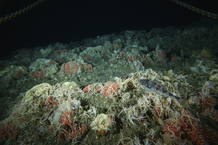
Stock Image provided by Australian Antarctic Division. EFE
RTVE.es / AGENCIES
The scientific community met for the first time in a biodiversity atlas of Antarctica with detailed description of 9,000 marine species that inhabit this place on Earth from tiny microbes to large cetaceans.
The biogeographic Atlas Australha Ocean been developed over four years by an international team of marine biologists and oceanographers and contributions of more than a hundred scientists from Australia, New Zealand , United States, France, Belgium, Spain or Chile.
This work, coordinated by the Scientific Committee on Antarctic Research (SCAR) and presented at a scientific conference held in New Zealand this week contains 66 chapters complete and comprehensive data of some 9,000 species and 800 maps and 100 color photographs. Data has been collected on the presence, evolution, genetic changes and effects of climate change on all of them.
“For the first time since the years when Captain Cook explored the Antarctic, the scientific community has gathered, analyzed and mapped marine diversity of this environment on a comprehensive atlas, a database accessible to facilitate the conservation of wildlife “stressed Europa Press the main editor and researcher at the Royal Belgian Institute of Natural Sciences of Broyer Claude.
Despite the challenge of collecting this wealth of information, such as details of the 9000 Antarctic marine species, still left out details about 1000 to 2000 species that have been discovered in the area and are in museums waiting for them to study and even that is put a name, explained to Efe Australian scientist Michael Stoddart, scientific former head of the Australian Antarctic Division (AAD).
However, the atlas is valuable because “it’s the first time together in one place, in the biogeographical atlas, the information gathered in many years of research and will serve as a milestone for future studies in Antarctica “, said Stoddart.
A richer variety than expected previously
This scientist recalls that, in the International Polar Year was held in 2007, an expedition led by Australia “found that species diversity in these areas was unexpectedly richer than previously thought and molecular techniques showed that Antarctica was the origin of many species “.
So I gave the example of a species of octopus that existed in Antarctica 30 million years ago and was driven by ocean currents to colonize many parts of the oceans.
atlas contains data going back to the 1940s and have been transferred to a large bank of digital data . In some cases there are very detailed marine maps that reflect the deep ocean seamounts, for example, but “two thirds of the planet is covered with water and the Antarctic Ocean is vast,” said Stoddart.
But there is still an outstanding debt which is the depth of research areas of Antarctic glacial deep ocean, which is difficult to access.
Much to do about climate change
On the impact of climate change, Stoddart said “not yet have complete information, but for example the data of terrestrial Antarctic species indicate that a species of penguin, for example, is moving more south of the Antarctic , presumably in search of a cooler environment. “
” We are improving, but there is much to do, “says the scientist, also open the door for further research on the effects of climate change.
He cited a change of climate “like 20 million years ago caused significant changes in fish and Antarctic crustaceans.”
According to Graham Hosie, head of editing several chapters of this atlas, the “biogeographic information is crucial to find the trouble spots, understanding environmental change, biodiversity monitoring and support strategies for sustainability and conservation.”
No comments:
Post a Comment